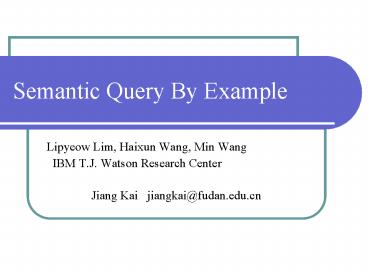Semantic Query By Example PowerPoint PPT Presentation
1 / 30
Title: Semantic Query By Example
1
Semantic Query By Example
- Lipyeow Lim, Haixun Wang, Min Wang
- IBM T.J. Watson Research Center
- Jiang Kai jiangkai_at_fudan.edu.cn
2
Outline
- Introduction
- Background
- Semantic Query By Example
- Feature Extraction
- Learning Query Semantics
- Active Learning for QBE
- Experiments
- Conclusion
3
Introduction
- Urgent need to incorporate ontology into the
realm of RDBMS to support semantic queries - Difficulties in semantic query on ontology
- Integrate data and its related ontology
- Express semantic queries
4
Examples EMR
- Different disease codes for the same symptoms
- Iris Neoplasm, Tumor of the Uvea, Eye
Neoplasm
5
(No Transcript)
6
Example
- Query find all patients diagnosed with eye tumor
- RDF-like data model, store ontology in
Thesaurus(src, rel, tgt)
7
Example
- XML format
8
Challenge
- Hard to write the query and needs to have an
intimate knowledge of the structure of the
ontology - Fuzziness in the semantics of the query
- Eg. Find all patients diagnosed with some disease
in the choroid (???) , which is part of eye.
Relationships linking disease concepts to
anatomic locations Disease_Has_Primary_Anatomic_S
ite, Disease_Has_Associated_Anatomic_Site,
Disease_Has_Metastatic_Anatomic_Site
9
Contributions
- A novel approach to address the problem
- A novel QBE (Query By Example) method
- Active learning to improve the accuracy of query
semantics modeling - Experimentally validate the effectiveness of the
method with as few as 2-4 user-given examples
10
Review on QBE
- First proposed in 1970s, two common
characteristics - The examples are used to specify a query that
will be generated - The generated query is a normal query in terms
that all the query conditions are defined on the
base attributes in the underlying tables in the
database - The novel semantic QBE framework
- Learn the query processing directly without
learning the query first - Not only on the base attributes but also
semantics of the base data encoded in the
ontology and the connections between them
11
Background
- Supervised Learning
- Create a function f from a training dataset
- Predict any valid input object x as yf (x)
- Accuracy depends largely on the quality of the
training dataset - Active Learning
- Situations in which unlabeled data is abundant
but labeling data is expensive - Query the user for labels of examples
- Graph Classification
- Classify object (graph/subgraph) based on a set
of labeled graphs - Classify vertices on a graph
- Vertices and edges in the ontology have their own
content
12
Semantic Query by Example
- Query posed against a base table D(X,OID)
- Offline process
- Compute the feature vector associated with OID
- Online process
- User poses a query by giving a set of example
tuples. SVM learn a model from the examples - User determine whether predictions is accurate
for an additional small no. of tuples
13
Feature Extraction
- Challenges
- Feature space must capture enough information so
that all discriminative features are covered - Vectorize the local hierarchical structure of an
ontology node - Naïve scheme include immediate child nodes
parent nodes, paths to some important nodes - Nodes and paths still complex
- Not general enough
- Alternative perform feature extraction per query
- Expensive
- Require user to know what part of ontology are
important
14
Shortest distance based feature extraction
- Ontology has a set of concepts Cc1,ck.
f(OID)lty1,ykgt, yi is the shortest distance from
node o to any node whose concept is ci. - Omits much information in the ontology
- Treat the ontology as an undirected graph
- Disregard the labels of the edges, concentrate
only on the labels of the nodes - Effectively capture the local structures
- Tell how close a node is to different concepts
- Infer much hierarchical information since the
distribution of concepts is not uniformly random
15
Example
16
Example
- Find nodes that are parent nodes of any node of
concept C
17
Implementation
18
Learning Query Semantics
- User provides examples following format (X,
OID, label), label ?1, -1 - Randomly pick a set of tuples Pn in D and label
them as negative. - Tuples satisfying the query is a small
proportion, classifier usually can overcome such
noise
19
Support Vector Machine
- SVMs learn a linear decision boundary to
discriminate between the two classes. - SVM trained from dataset (xi, labeli) specifies a
linear classification rule by a pair (w, b),
where w ?RN, f(x) wx b, where x is
classified as positive if f(x)gt0, or negative if
f(x)lt0. - Decision boundary x ?RN wx b0
20
SVM
- Optimal boundary
21
Active Learning for QBE
- Iteratively select the best example to
incorporate into the training dataset to obtain a
high quality classifier
22
Experiment
- Queries
23
Varying the no. of positive examples
- Table size1000, training dataset 40
- Query selectivity 10
24
Varying the num of training examples
- Num of positive examples 8
- Query selectivity 10
25
Varying the num of training examples
26
Varying query selectivity
- Num of training examples 160
- Num of positive examples 8
27
Varying table size
- Num of training examples 160
- Num of positive examples 16
- Query selectivity 5
28
Processing time
- Processing a query by example on a table of size
10,000 takes only 0.25 sec
29
Conclusion
- Introduce a data mining approach to support
semantic queries in relational database - Dealing with the ontology directly when asking
semantic queries - Efficient, effective and general in supporting
semantic queries
30
The End
- Thank you all!

